An international team of researchers have dated painted art found on the walls and inside four caves in Spain and discovered that the oldest known art in the world long predates behaviorally modern humans. Previously believed to be solely the province of Homo sapiens, the painted walls and marine shells are indisputably the work of Neanderthals.
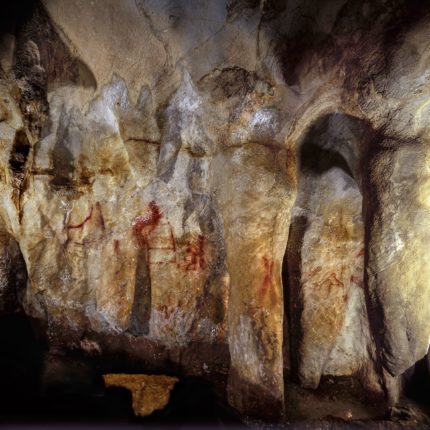
La Pasiega, section C. Cave wall with paintings. The scalariform (ladder shape) composed of red horizontal and vertical lines (centre left) dates to older than 64,000 years and was made by Neanderthals. (Credit: P. Saura)
The paint is made of mineral pigment, not charcoal, so it’s not possible to use radiocarbon dating to figure out how old they are. Instead, researchers turned to the calcium carbonate crusts that formed on top of the paintings when water dropped down the wall. The art has to be older than the calcite, ergo, dating the calcite gives a minimum age of the paintings.
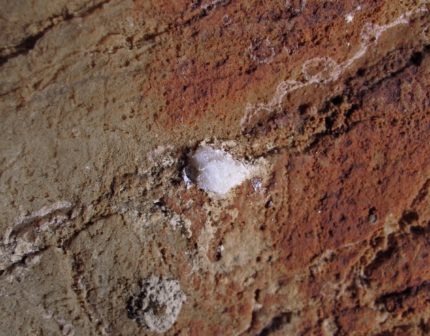
Calcite crust on top of the red scalariform sign. The U-Th method dates the formation of the crust which gives a minimum age for the underlying painting.
(Credit: J. Zilhão)
The technology used, Uranium-Thorium dating, requires a very small sample and returns more precise dates going back further in time than radiocarbon dating based on the radioactive decay of Uranium into Thorium. Researchers tested more than 60 carbonate samples from cave paintings in three Spanish sites, La Pasiega, in Cantabria, north-eastern Spain, Maltravieso in Cáceres, western Spain, and Ardales in Andalusia, southern Spain.
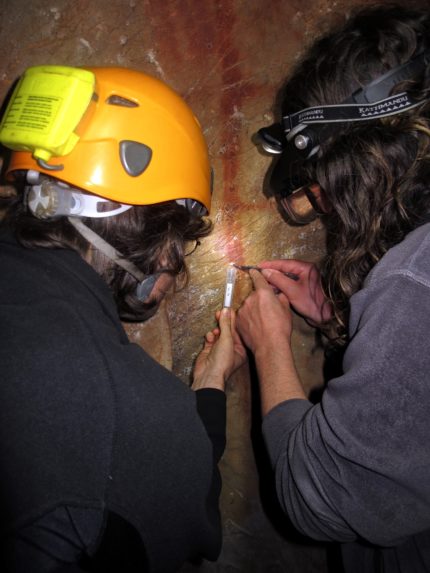
Dirk Hoffmann and Alistair Pike sampling calcite from a calcite crust on top of the red scalariform sign in La Pasiega. (Credit: J. Zilhão)
The results found that the paintings are at least 64,000 years old. In La Pasiega, the ladder with animal shapes in the interior rectangles and dots on the inside is a minimum of 64,800 years old. The red-painted speleothems in the Ardales cave are more than 65,500 years old. A hand stencil in Maltravieso is more than 66,700 years old. All of them long predate Homo sapiens‘ arrival in Spain who only moved to the area 40,000 years ago. The results of the testing have been published in the journal Science and can be read here.


Left: Panel 3 in Maltravieso Cave showing 3 hand stencils (centre right, centre top and top left). One has been dated to at least 66,000 years ago and must have been made by a Neanderthal. (Credit: H. Collado) Right: Color enhanced version of Panel 3. (Credit: H. Collado)
Samples from all three caves from the north, center and south of the peninsula date to the time when Neanderthals were the only human species in the area, which means these paintings aren’t random or some one-off fluke, but rather a conscious, well-developed cultural approach with specific symbolic meaning and thoughtful application. The locations, all of them in the depths of caves where they did not live, light sources and pigments were chosen with careful deliberation to make their artistic and spiritual visions come to life.
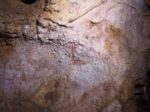

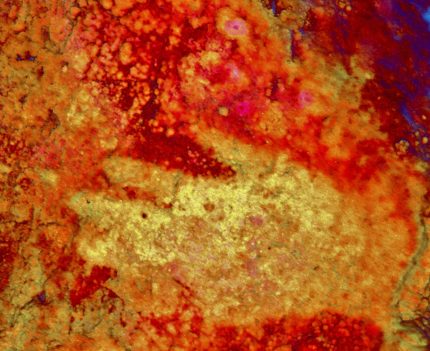
Left: Cave wall in Maltravieso with Neanderthal hand stencil, almost completely covered with calcite. It is older than 66,000 years. (Credit: H. Collado) Center: Color enhanced version of stencil. (Credit: H. Collado) Right: Detail of stencil, color enhanced. (Credit: H. Collado)
Even older examples of the Neanderthal ability to convert abstractions into art have been found in southeast Spain in the Cueva de los Aviones. Marine shells discovered there are pigmented with red and yellow and perforated. Again using Uranium-Thorium dating, the team has dated the flowstone covering the shells to an astonishing 115,000 to 120,000 years old. Homo sapiens produced similar pieces but the earliest of them date to between 20,000 and 40,000 years ago.


Left: A shell with remnants of pigments found in sediments in Cueva de los Aviones. It dates to between 115,000 and 120,000 years. (Credit: J. Zilhão) Right: Perforated shells found in sediments in Cueva de los Aviones and date to between 115,000 and 120,000 years. (Credit: J. Zilhão)
The results of the shell dating study have been published separately in Science Advances and can be read here.
“Neanderthals created meaningful symbols in meaningful places”, says Paul Pettitt from University of Durham, also a team member and cave art specialist. In the Cueva Ardales, where excavations are currently being conducted by a German-Spanish team, the presence of Neanderthals has also been proven from analysing occupation layers. “This is certainly just the beginning of a new chapter in the study of ice age rock art”, says Gerd-Christian Weniger of the Foundation Neanderthal Museum Mettmann, one of the leaders of the Ardales excavations. […]
“According to our new data Neanderthals and modern humans shared symbolic thinking and must have been cognitively indistinguishable”, concludes João Zilhão, team member from the Catalan Institution for Research and Advanced Studies in Barcelona and involved in both studies. “On our search for the origins of language and advanced human cognition we must therefore look much farther back in time, more than half a million years ago, to the common ancestor of Neanderthals and modern humans.”
When the fossilized remains of Neanderthals were first discovered in the 19th century, one of the proposed names for the hominid species was Homo stupidus. They were held to be apelike and unintelligent, incapable of abstract or symbolic thought. The confirmation that they were not only capable of symbolism but also pretty freaking phenomenal artists puts to rest those old prejudices once and for all. Neanderthals were just as cognitively capable as modern humans.

Cueva de los Aviones, seen from the breakwater of Cartagena harbour. (Credit: J. Zilhão)
Hi, I love this blog. I’d really like to know what you think about the idea that modern humans left Africa earlier than 60,000 years ago. The researchers in the article seem to be using the dates as absolute guarantees of who made the art, but the dates of migration seem to be somewhat debated. BBC article about modern human remains outside of Africa 185,000 BP
Would love to know what you think.
——-
“The researchers conclude that our cousins’ cognitive abilities were equivalent to our own.”
——-
Frankly, I sometimes worry about my cousins’ cognitive abilities, but actually I could imagine both, i.e. ‘Neanderthals’ being cognitively ‘abler’ than e.g. my cousins, as well as ‘modern’ humans being around ‘earlier’ than previously thought.
At the end of the day, they had sex with each other, and the Neanderthal bit was then -i.e. to a remainder that brought a competitive advantage- genetically drifted out, over a timespan of several millennia – until pen and paper were invented.
They definitely mixed it up with the Cro-Magnum “arrivistes.” A first cousin, of Spanish ancestry, found after his DNA analysis, that 3% of his ancestry was Neanderthal.
Like your new photo captions. Thank you.
I wish I could be around 100 years from now to see how much more they learn about the true nature of Neanderthals.
———————-
“…interbreeding between modern humans and Neanderthals: Neanderthal DNA in present-day humans outside Africa originates from interbreeding that occurred 47,000 – 65,000 years ago (green arrow). Modern human DNA in Neanderthals is likely a consequence of earlier contact between the two groups roughly 100,000 years ago (red arrow).”
———————-
The above caption text taken from here, referring to: Martin Kuhlwilm et al.: Ancient gene flow from early modern humans into Eastern Neanderthals. In: Nature. Band 530, 2016, S. 429–433. In earlier studies, there had already Neanderthal DNA been found in modern humans. “They suggest that some modern humans left Africa early and mixed with Neanderthals. These modern humans later became extinct and are therefore not among the ancestors of present-day people outside Africa who left Africa about 65,000 years ago.”
In the words of one of the authors: “We knew from Neanderthal DNA found in the genomes of humans outside Africa that Neanderthals and humans have interbred. This interbreeding is estimated to have happened less than 65,000 years ago, around the time that modern human populations spread across Eurasia from Africa. We now find evidence for a modern human contribution to the Neanderthal genome. This is likely the result of much earlier interbreeding”.
:hattip:
—————-
PS: What later would become Israel (as in the BBC article referred to above) as an ‘earlier’ meeting point makes sense, i.e. at least to me it does.
Confront your cheating spouse with evidence, I was able to spy on my cheating ex phone without finding out…..it really helped me.. contact hotcyberlord at gmail dot com or call and text +15402277725 for spying and hacking social networks, school servers, icloud and much more, viber chats hack,retrieving deleted texts of any kind. Facebook messages and yahoo messenger, calls log and spy call recording, monitoring SMS text messages remotely, cell phone GPS location tracking, spy on Whats app Messages.
Email: hotcyberlord at gmail dot com
text num:+15402277725
tell him jane referred you.
Fascinating if true. More finds elsewhere would make its being true likelier. But I still have to grin at the archaeologists’ ability to leap from plausible premise to unsupported conclusion: “Neanderthals were just as cognitively capable as modern humans”.
@dearieme: that exaggerated conclusion surprised me as well. On the other hand, Neanderthals did have larger brains than modern humans, which they must have put into use one way or another. So they probably had well-developed cognitive abilities, but maybe of a different sort than those of H. Sapiens. So perhaps the problem is that our definition of ‘cognition’ is rather Homo sapiens-centred.
And @ Toby: what you’re saying about the migration out of Africa is true, but according to genetic evidence, these early migrations did not contribute to the gene pool of people living outside of Africa today. This, together with the lack of archeological evidence for an earlier colonisation of the European continent by modern humans, makes it, in my opinion, save to say that Neanderthals made the art.
Oh btw: facinating finding! And I can’t help remarking on the interesting use of the term “behaviourally modern humans” in the 1st sentence, since the use of art is one of the defining characteristics of behavioural modernity. Maybe we should now consider the Neanderthals part of behaviourally modern humans as well :yes:
With all the craziness going on in the world today, I have no problem in believing that the Neanderthals were as capable ,or even more so, than us.
Yeah, I’m sure they were capable of rock music.
Cant believe it— just now I got the “rock music”
While we apparently got higher intelligence from the Neanderthals, Europeans should curse the Neanderthals for what we lost :
https://thinkpatriot.wordpress.com/2015/01/19/neanderthal-genome-researchers-missed-importance-of-own-data/
Actually, we have a very good understanding when the works were created, because they wrote the dates. Moreover, carbon or u-series dating methods are useless, because the cave libraries were perpetually maintained over the millenniums, thus scientific dating methods only tells us the end date, when the project was abandoned.
The cave of Altamira, for example, is exclusively dedicated to building galactic knowledge, i.e., the earth’s axial procession (Great Age). That’s what the bison in the cave are expressions of; visual puns of the galactic core’s drift along the Western and Eastern horizons over the course of a Great Age.
Follow the link given below, which is a brief illustrated explanation, because, and to use a cliché, an illustration is worth a thousand words:
https://linguistic-determinism-art-language.blogspot.com/